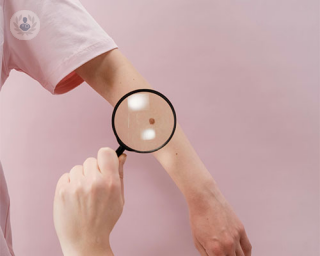Skin flap
Mr Thomas Bragg - Plastic surgery
Created on: 03-10-2020
Updated on: 03-30-2023
Edited by: Karolyn Judge
What is a skin flap procedure?
The skin flap procedure is a common method used to cover large or deep wounds or to repair damaged skin. A flap of healthy skin and its blood vessels are partially lifted and repositioned from the donor site to cover a nearby wound. A flap may also contain cartilage, muscle or fatty tissue, depending on the requirements of the wound that needs covering.

Why is it done?
A skin flap can be used to cover skin defects or wounds that are too large to allow the skin to be pulled together for stitches. These wounds can occur from:
- deep cuts;
- fractures in which a bone has pierced the skin;
- skin or tissue removal, such as cancer surgery.
The skin flap procedure is also a technique used in breast reconstruction surgery.
What does skin flap surgery involve?
Skin flap surgery involves surgically removing living and healthy tissue from one part of a patient’s body and repositioning it to another part that is very close to the donor site. Local or general anaesthetic can be used and this depends on the extent of the skin flap procedure. The flap will remain attached at one end in order to maintain the blood supply that keeps the skin alive. Once the skin flap is successfully positioned over the wound, the site is closed with skin glue, staples or stitches.
In the majority of cases, the flap is a section of skin that is partly lifted and pulled to cover a neighbouring wound. However, some injuries may require the 'free flap' technique, which is when the donor site is not adjacent to the wound. The skin and its blood vessels are completely detached from the donor site and reattached at the new site via microsurgery (surgery with a microscope), rather than remaining partially connected to the original site.
Aftercare
While the skin flap heals and fully attaches itself to the new location, it is advised to keep both the donor and flap site clean to avoid infection. It is also advised to avoid touching the sites and to restrict movement to prevent the skin from being stretched. Your specialist will advise you on when you can return to regular activity and sport.
Alternatives to the skin flap procedure
Skin grafts and skin flaps share a similar purpose. However, skin grafts are often used for larger or deeper wounds that a flap cannot cover.


